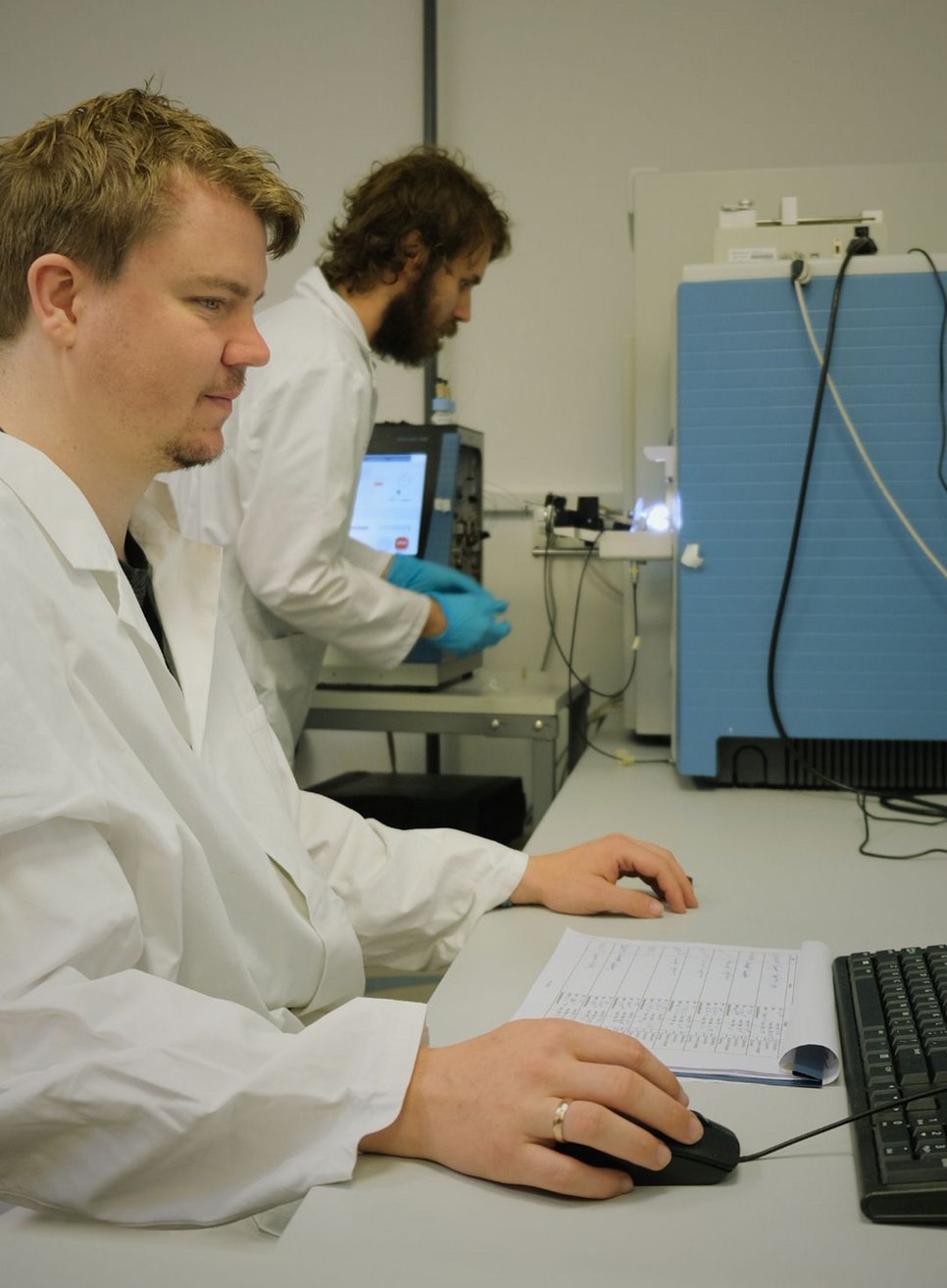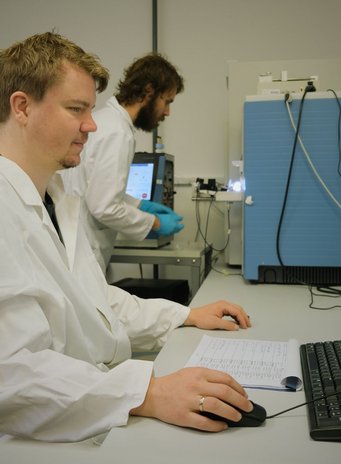Technology/Methodology
Diese Inhalte sind derzeit nur in englischer Sprache verfügbar.
Mass Spectrometry
At the core of our work are three highly resolving performance mass spectrometers of the Q Exactive class by Thermo Fisher Scientific: a Q Exactive Classic and two Q Exactive HF instruments.
Liquid Chromatography and Interfacing
The nano–flow capillary liquid chromatography in–line to the mass spectrometers is provided by Thermo Fisher Scientific EASY–nLC instruments and coupled to the mass spectrometers by electrospray ionization using in–house produced reversed phase column emitters.
Supporting Instrumentation
Beyond the core liquid chromatography/tandem mass spectrometry (LC/MS2) setups, the Service Group is equipped with the full complement of necessary supporting instrumentation including microflow high performance liquid chromatography (HPLC) instrumentation for off–line analyte separation, various ultrasound sonicators for sample homogenization, vacuum concentrators, spectrophotometers for colorimetric assays and functional analysis in the context of membrane biology.

Protocols Offered
Proteomic Sample Prep
Adapting to the specific requirements of protein samples in their experimental context and embedding matrix, we offer a broad range of lysis, precipitation and solid phase extraction, in–solution and in–gel peptidolysis, as well as off–line separation protocols, performed on collaborator’s samples by the Service Group.
Modes of Quantitation
For comparative quantitation in proteomic analysis, the Service Group offers a comprehensive set of approaches:
- Label Free Quantitation (LFQ) allows for sensitive, imprecise relative quantitation with zero multiplexing capabilities (one LC/MS2 analysis per sample) and applicable to all biological systems. For difficult sample matrices this approach in conjunction with in–gel petidolysis is the method of choice.
- Stable Isotope Labeling with Amino Acids in Tissue Culture is the gold standard in quantitation precision and allows for mixing of samples to be compared even as early as cell equivalents, thus allowing for the control even of variable cell lysis. As SILAC is a metabolic labeling strategy, growth conditions for model systems to be analyzed must, however be heavily adapted, application to non–cultured systems is difficult and direct use for human samples impossible. SILAC allows for multiplexing up to three samples in a single LC/MS2 analysis.
See Ong et al. (2002) and Ibarrola et al. (2003) for more information.
- Chemical Labeling by Reductive Dimethylation (Billing, Hamidane, and Graumann 2017; Boersema et al. 2009) provides characteristics roughly equivalent to those of SILAC, yet isotopic labeling is achieved by chemically modifying peptides during sample preparation. While the strategy on the one hand circumvents the problems related to metabolic labeling in vivo and is thus applicable to samples irrespective of their origin, sample processing from tissue homogenization through peptidolysis and chemical labeling is, on the other hand, performed in parallel – with the implied risk of introduced bias and artifacts.
When considering cost, ease of handling, multiplexing potential (three as for SILAC) and precision of quantitation, reductive dimethylation is the general method of choice of the Service Group for relative quantitation.
- Tandem Mass Tags (TMT; Thompson et al. 2003) is another stable isotope–based chemical labeling technique of particular elegance. It combines the advantages and disadvantages of peptide level labeling (see “Reductive Dimethylation” above) with the option to multiplex up to six samples per LC/MS2 analysis without expanding the spectral complexity afflicting both the SILAC and Reductive Dimethylation strategies. These benefits come at the expense of a significant price tag of the commercial product (by Thermo Fisher Scientific) and a ratio compression effect biasing observations towards those with a large effect size (Ting et al. 2011). Thus and as instrumentation to remedy the latter effect is not part of our arsenal, the Service Group recommends this mode of quantitation only where the multiplexing capabilities in combination with high sensitivity are required.
As the scientific questions tackled at the institute frequently imply the necessity to analyse rare cellular populations, we have implement the TiSH (TiO₂–SIMAC–HILIC; Engholm-Keller and Larsen 2016; Engholm-Keller et al. 2012) protocol, requiring only approximately 300 μg of protein input material and delivering routinely up to 15,000 phospho–sites (significantly less for muscle tissue and other samples with extreme dynamic range of protein abundance). This protocol is labor and time intensive and thus only offered following intensive consultation and in the context of well controlled experiments. All quantitation modes offered but Label Free Quantitation are compatible with the approach.
Data Analytical Infrastructure
Analysis of Mass Spectrometrical Raw Data (ID & Quantitation)
As it combines all features required for the workflows offered, the Service Group uses the MaxQuant suite of software tools (Cox and Mann 2008; Cox et al. 2014), including the Andromeda search engine for peptide spectrum matches (PSM; Cox et al. 2011).
Downstream Reporting and First Pass Data Analysis
MaxQuant–provided data is analyzed bioinformatically using a common denominator set of analytical techniques implemented in the in–house R package autonomics centered on functionality from limma (Ritchie et al. 2015). Along with documentation of sample prep, LC/MS2 and MaxQuant analysis, the results are packaged into an immutable, reproducible PDF report aiming to provide a single point of reference for the entire proteomics analysis and to prevent the need for “data archaeology” when publishing (frequently years in the future).
Bibliography
Billing, Anja M., Hisham Ben Hamidane, and Johannes Graumann. 2017. “Quantitative Proteomic Approaches in Mouse: Stable Isotope Incorporation by Metabolic (SILAC) or Chemical Labeling (Reductive Dimethylation) Combined with High-Resolution Mass Spectrometry.” Current Protocols in Mouse Biology 5 (1): 1–20. https://doi.org/10.1002/9780470942390.mo140156.
Boersema, Paul J, Reinout Raijmakers, Simone Lemeer, Shabaz Mohammed, and Albert J R Heck. 2009. “Multiplex Peptide Stable Isotope Dimethyl Labeling for Quantitative Proteomics.” Nat. Protocols 4 (4): 484–94. https://doi.org/10.1038/nprot.2009.21.
Cox, Jürgen, Marco Y. Hein, Christian A. Luber, Igor Paron, Nagarjuna Nagaraj, and Matthias Mann. 2014. “Accurate Proteome-Wide Label-Free Quantification by Delayed Normalization and Maximal Peptide Ratio Extraction, Termed MaxLFQ.” Molecular & Cellular Proteomics 13 (9): 2513–26. https://doi.org/10.1074/mcp.M113.031591.
Cox, Jürgen, and Matthias Mann. 2008. “MaxQuant Enables High Peptide Identification Rates, Individualized p.p.b.-Range Mass Accuracies and Proteome-Wide Protein Quantification.” Nature Biotechnology 26 (12): 1367–72. https://doi.org/10.1038/nbt.1511.
Cox, Jürgen, Nadin Neuhauser, Annette Michalski, Richard A. Scheltema, Jesper V. Olsen, and Matthias Mann. 2011. “Andromeda: A Peptide Search Engine Integrated into the MaxQuant Environment.” Journal of Proteome Research 10 (4): 1794–1805. https://doi.org/10.1021/pr101065j.
Engholm-Keller, Kasper, Pernille Birck, Joachim Størling, Flemming Pociot, Thomas Mandrup-Poulsen, and Martin R. Larsen. 2012. “TiSH — a Robust and Sensitive Global Phosphoproteomics Strategy Employing a Combination of TiO2, SIMAC, and HILIC.” Journal of Proteomics 75 (18): 5749–61. https://doi.org/10.1016/j.jprot.2012.08.007.
Engholm-Keller, Kasper, and Martin R. Larsen. 2016. “Improving the Phosphoproteome Coverage for Limited Sample Amounts Using TiO2-SIMAC-HILIC (TiSH) Phosphopeptide Enrichment and Fractionation.” In Phospho-Proteomics, edited by Louise von Stechow, 161–77. Methods in Molecular Biology. Springer, New York, NY. https://doi.org/10.1007/978-1-4939-3049-4_11.
Ibarrola, Nieves, Dario E. Kalume, Mads Gronborg, Akiko Iwahori, and Akhilesh Pandey. 2003. “A Proteomic Approach for Quantitation of Phosphorylation Using Stable Isotope Labeling in Cell Culture.” Analytical Chemistry 75 (22): 6043–49. https://doi.org/10.1021/ac034931f.
Ong, Shao-En, Blagoy Blagoev, Irina Kratchmarova, Dan Bach Kristensen, Hanno Steen, Akhilesh Pandey, and Matthias Mann. 2002. “Stable Isotope Labeling by Amino Acids in Cell Culture, SILAC, as a Simple and Accurate Approach to Expression Proteomics.” Molecular & Cellular Proteomics 1 (5): 376–86.
Ritchie, Matthew E., Belinda Phipson, Di Wu, Yifang Hu, Charity W. Law, Wei Shi, and Gordon K. Smyth. 2015. “Limma Powers Differential Expression Analyses for RNA-Sequencing and Microarray Studies.” Nucleic Acids Research 43 (7): e47–e47. https://doi.org/10.1093/nar/gkv007.
Thompson, Andrew, Jürgen Schäfer, Karsten Kuhn, Stefan Kienle, Josef Schwarz, Günter Schmidt, Thomas Neumann, and Christian Hamon. 2003. “Tandem Mass Tags: A Novel Quantification Strategy for Comparative Analysis of Complex Protein Mixtures by MS/MS.” Analytical Chemistry 75 (8): 1895–1904. https://doi.org/10.1021/ac0262560.
Ting, Lily, Ramin Rad, Steven P. Gygi, and Wilhelm Haas. 2011. “MS3 Eliminates Ratio Distortion in Isobaric Multiplexed Quantitative Proteomics.” Nature Methods 8 (11): 937–40. doi.org/10.1038/nmeth.1714.
